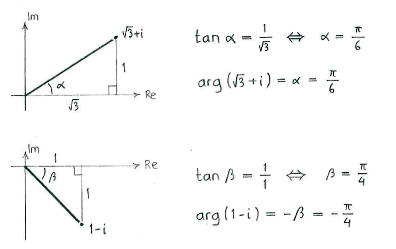Lösung 3.2:5c
Aus Online Mathematik Brückenkurs 2
Geometrically, the multiplication of two complex numbers means that there magnitudes are multiplied and their arguments are added. The product \displaystyle \left( \sqrt{3}+i \right)\left( 1-i \right) therefore has an argument which is the sum of the argument for the \displaystyle \sqrt{3}+i and \displaystyle 1-i, i.e.
\displaystyle \arg \left( \left( \sqrt{3}+i \right)\left( 1-i \right) \right)=\arg \left( \sqrt{3}+i \right)+\arg \left( 1-i \right)
By drawing the factors in the complex plane, we can determine relatively easily the argument using simple trigonometry:
(Because
\displaystyle 1-i
lies in the fourth quadrant, the argument equals
\displaystyle -\beta
and not
\displaystyle \beta .)
Hence,
\displaystyle \begin{align}
& \arg \left( \left( \sqrt{3}+i \right)\left( 1-i \right) \right)=\arg \left( \sqrt{3}+i \right)+\arg \left( 1-i \right) \\
& =\frac{\pi }{6}-\frac{\pi }{4}=-\frac{\pi }{12} \\
\end{align}
NOTE: if you prefer to give the argument between
\displaystyle 0
and
\displaystyle 2\pi , then the answer is
\displaystyle -\frac{\pi }{12}+2\pi =\frac{-\pi +24\pi }{12}=\frac{23\pi }{12}

